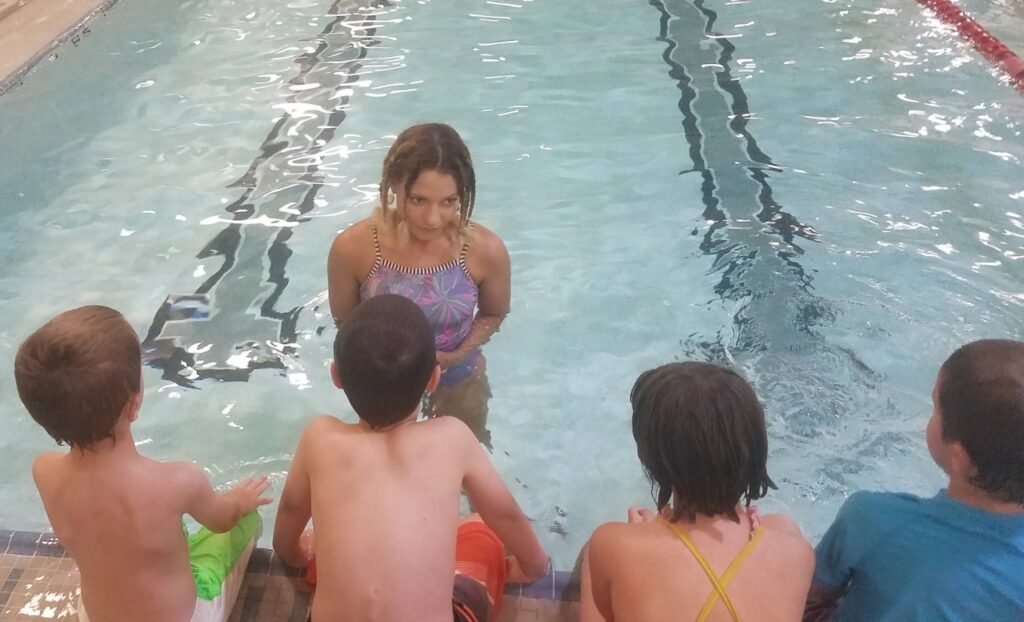With so many lakes and streams in the Black Hills, water safety should be top of mind…even if you aren’t planning on going for a dip.
“Drowning is the leading cause of death in children,” explains Frances Seeley, Aquatics Director with the YMCA of Rapid City. “And the biggest prevention tool for that is swimming lessons.”
The YMCA is the perfect place to learn how to swim. With programs geared toward people of all ages, from six months to 99 years, and classes available year-round, there’s no excuse not to dive right in (pun intended). Instructors place a strong emphasis on self-safety for swimmers both young and old, teaching them not to swim without a lifeguard on duty and to use caution any time they are around water when no lifeguard is present. For kids, the focus is on providing SAW (safety around water) components—teaching them how to swim, and also, how to save themselves in the event they inadvertently end up in the water.
The entire swimming program was revamped in 2017 to introduce SAW components into even the earliest levels. For example, one of the first lessons children are taught involves climbing out of a pool safely should they accidentally fall in using an elbow/elbow/tummy/knee “crawl” instead of trying to heave themselves out. Other skills include learning how to float on their front, flip over onto their back, and a “jump, push, turn, and grab” maneuver that teaches them to jump in the water, touch the bottom, push off the bottom, and grab onto the wall. As the students progress, they move on to more complicated skills.
Swimming lessons are built around a progression-level program: there are four levels for preschoolers and seven levels for youths. Everybody starts at the beginner level and must master various skills before progressing. There are five six-week segments available during the school year, with an additional five two-week segments offered during the summer. During the school year, students are encouraged to take lessons twice a week, but Frances acknowledges that with busy schedules, once a week—usually Friday or Saturday—is most popular. The summer lessons run for four consecutive days (Monday through Thursday) for two weeks, and are a great way to really boost skills quickly.
Preschool students who are enrolled in the YMCA’s all-day childcare program receive complimentary swimming lessons as part of their curriculum. “It’s not unusual for a five year old who started in our childcare program at age three to swim a length of the pool easily doing the crawl stroke by the time they leave,” Frances says. “That’s not the norm for a five year old.”
There are plenty of benefits to swimming beyond drowning prevention. It’s a lifelong sport, for starters; even people who have suffered injuries can adapt swimming as part of their routine. The same can’t be said for a runner who suffers from shin splints. Swimming provides excellent cardiovascular benefits and teaches rhythmic breathing. Keiz Larson, Chief of Operations, points out another important benefit.
“Swimming is a life skill,” she says. “So many recreational activities in the Black Hills are in and around water. I’m not a big swimmer personally, but I’m comfortable doing things that involve water because I know how to swim.”
Even families who are struggling financially have an opportunity to have their kids learn how to swim. “The YMCA is incredibly focused on youth swim lessons,” Keiz explains. “It’s so important that kids learn to swim, we don’t want there to be an economic barrier for children. Part of the YMCA’s mission is to ensure that even if families can’t afford swimming lessons, we have a scholarship program they can apply for.”
Nationally, the YMCA has a swim access grant that allows local facilities to provide opportunities for 100 at-risk youth to learn how to swim. While at-risk has traditionally referred to minorities and socioeconomically disadvantaged kids, in the Black Hills communities around Rapid City, all children are considered at-risk simply because of the numerous lakes, ponds, and streams throughout the region, an addition to the lack of swimming pools and lessons in those locales.
Contact the YMCA directly for more information about their swimming programs.
Written by Mark Petruska



